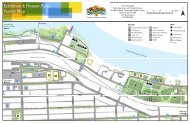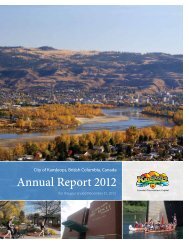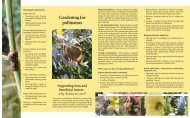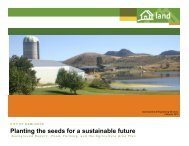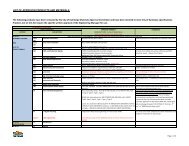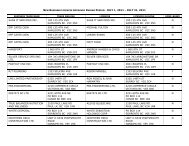XERISCAPE - City of Kamloops
XERISCAPE - City of Kamloops
XERISCAPE - City of Kamloops
You also want an ePaper? Increase the reach of your titles
YUMPU automatically turns print PDFs into web optimized ePapers that Google loves.
CREATING A KAMLOOPS<strong>XERISCAPE</strong>“water conservation throughcreative landscaping”healthy landscapeshealthy living
Xeriscape is not “Zeroscape”The term is pronounced “zair-i-scape” and means “water conservation throughcreative landscaping.” It combines the Greek word “xeros” meaning dry, and “scape”denoting a view.We all love beautiful surroundings. Xeriscaping is a method <strong>of</strong> gardening that doesn’tsacrifice beauty to conserve water. In fact, if a landscape isn’t attractive, then it isn’t axeriscape. The principles <strong>of</strong> xeriscaping can be applied to any landscape style and canbe as plain or elaborate as desired.Reasons to XeriscapeThe average Canadian uses 326 litres <strong>of</strong> water per day. The average <strong>Kamloops</strong> residentuses about 800-850 litres <strong>of</strong> water per day. In the summer, the peak water demand risesto 1750 litres <strong>of</strong> water per person, per day! Eighty percent <strong>of</strong> the water consumed in thesummer is used outdoors to water grass, hose driveways and to wash vehicles.In addition to using less water, a xeriscape garden requires less weeding, fertilizing,pruning, mowing and pesticides.Xeriscaping in <strong>Kamloops</strong><strong>Kamloops</strong> summers are hot and dry, and our winters can be cold. We receive about21.8 cm (8.5 inches) <strong>of</strong> rainfall per year. Kelowna receives 29.8 cm (11 inches), whileVancouver receives 155.5 cm (45.5 inches). So, plants that are considered xeriscapeelsewhere may not be suitable here.Are You Ready?By Xeriscaping our individual landscapes, we use water more responsibly. Even ifyou are not ready to do a complete make over, becoming more knowledgeable andaware <strong>of</strong> your existing landscape is a start. Here are two simple steps that will makea difference: alter your irrigation to match your plants actual water requirements, andmake adjustments to minimize overspray onto hard surfaces.Creating a <strong>Kamloops</strong> Xeriscape ~ Healthy landscapes healthy living
Xeriscape Principle #1 ~ Planning & DesignPlanningThe first and most important step in creating asuccessful xeriscape is careful planning. A good plan will save youtime and money. There are pr<strong>of</strong>essionals who can help you, but ifyou choose to do it yourself, here are a few tips:Take an Inventory• Sketch a simple bird’s-eye view <strong>of</strong> your property.• Take an inventory, walk around your yard and note what works well and whatcould change.• Measure and locate all elements that must remain (property lines, fences,driveways, walkways, retaining walls, utilities).• Identify conditions that will affect planting and water usage (sun, wind, shade,slopes, drainage, soil variations).• Note views you wish to maintain or eliminate, and where an irrigation systemcould be connected.Make a Wish List• Determine what each member <strong>of</strong> the household would like from the availableoutdoor space (recreation space, a place for relaxation and entertaining, ashowpiece, storage).• Prioritize the wish list and decide when you would like to complete the project,and how much it will cost.• Expand your horizons. Go for a drive and make notes on other yards. Visit theXeriscape Demonstration Garden at McArthur Island, as well as garden centresand nurseries. Consult magazines, the library, and home and garden showsfor ideas.
Xeriscape Principle #1 ~ Planning & Design (Continued)Prepare a Base Plan• Draw an accurate map <strong>of</strong> yourproperty to scale.• Draw in all elements from yourinventory that are to remain.Design Your XeriscapeBy this stage, you will have set goalsand identified any problem areasin your yard. Now it is time to findsolutions to those problems, keepingin mind the constraints <strong>of</strong> yourproperty, your aesthetic preferences,budget, and your functional andenvironmental objectives.Prepare a Concept Plan• Draw a simple sketch usingbubble shapes to outlinespecific areas. To do this, laytracing paper over your baseplan, and see if your wish list ispractical for your site.• Divide your sketch into outdoorrooms (entry, cooking/dining,play, garden, dog run).• Try a few alternatives to find theplan that best suits your needs.Creating a <strong>Kamloops</strong> Xeriscape ~ Healthy landscapes healthy living
Xeriscape Principle #4 ~ Practical Turf AreasLawns can add to the enjoyment <strong>of</strong> our yards, to property values, and help cool ourhomes in the summer, reducing energy for air-conditioners. However, most lawnsare much larger than required and consume high amounts <strong>of</strong> water in comparison tomost other plantings. (See Xeriscape Plants for water requirements).Take a look at your lawn and ask yourself these questions:• How much <strong>of</strong> my lawn is actually walked or played on?• Is it there because I don’t know what else to do with that area?• Are there areas that are difficult or dangerous to mow?• Could sections <strong>of</strong> the lawn be replaced by groundcovers, shrubs or ornamentalgrasses that need less water and maintenance?• Are there areas where hard surfaces like walkways or decks would make the livingspace more practical?Here are additional reasons to reduce large areas <strong>of</strong> lawn:Reduce Water PollutionIt is estimated that 60% <strong>of</strong> the nitrogen added to lawns ends up in our water suppliesdue to run<strong>of</strong>f from over-fertilizing and over-watering lawns. Pesticide use on lawnsalso contributes to water pollution through run-<strong>of</strong>f. In the US, an estimated 17 milliongallons <strong>of</strong> fuel are spilled each year while filling outdoor power equipment.Reduce Air PollutionThe amount <strong>of</strong> volatile organic compounds emitted by a 3.5 hp lawnmower runningfor one hour is equal to the emissions <strong>of</strong> a car being driven 550 kms.Reduce Noise PollutionThe less area <strong>of</strong> lawn you have to mow, the less disruption to the neighbourhood.Reduce Inflow to Our LandfillsGrass clippings should be left on the lawn or composted, however some still makes itsway to our landfill.Creating a <strong>Kamloops</strong> Xeriscape ~ Healthy landscapes healthy living
Healthy Lawn Care TipsMow High: Leave grass 5 - 7.5 cm (2 - 3”) tall. Thisshades the roots and helps prevent evaporation. It also helps yourgrass grow deep and strong roots that can overpower weeds andretain water. Leaving mulched grass clippings on your lawn canprovide about one-third <strong>of</strong> your lawn’s nutrient needs and are avaluable source <strong>of</strong> organic matter.Dethatch: Thatch is a mixture <strong>of</strong> dead grass and roots that accumulate and forma tough layer at the soil surface. Excessive watering, nitrogen or pesticides maycontribute to a situation where the thatch exceeds 1 cm (0.4”.) Excess thatch can beremoved using a stiff rake or specialized de-thatching equipment.Aerate: Aeration is the process <strong>of</strong> removing plugs <strong>of</strong> soil from your lawn, or makingholes in it with a tool like a pitch fork. This creates spaces for air, water and nutrients topenetrate into the soil and promotes the growth <strong>of</strong> beneficial microorganisms. It alsoincreases water absorption and reduces surface run<strong>of</strong>f.Topdress: Topdressing involves spreading good quality topsoil or compost on top <strong>of</strong>your lawn. This adds organic matter and improves the condition <strong>of</strong> the soil. Topdressingis essential on bare areas and on lawns with little topsoil. Add ¼ to ½ inch <strong>of</strong> topsoil orcompost. Don’t smother the grass blades.Overseed: Overseeding is the process <strong>of</strong> adding grass seed to your lawn. Use a highquality mix suited to the area.Water Deeply: When watering a lawn, water deeply, but infrequently. This meanswatering about one to two days per week, but when you do water, water to a depth <strong>of</strong>2.5 cm (1”).
Xeriscape Principle #5 ~ Water Wisely, Every Drop CountsOver-watering increases the risk <strong>of</strong> plant disease as well as attracts certain insects thatprefer lush, weak growth. To encourage deep rooting and drought-resistance, waterdeeply, thoroughly, and less <strong>of</strong>ten.Water restrictions are in effect from May 1st to August 31st. Even house addresses maywater on even days and odd addresses on odd days. However, it is not in your plants’best interests to water every second day.Proper watering for your landscape will depend on:• Soil type• Weather• Location• Wind exposure• Type <strong>of</strong> plantsTry this test to determine when to water for YOUR landscape beds:Squeeze a handful <strong>of</strong> soil• If too dry to form a ball - waited too long• If it forms a crumbly ball - time to irrigate• If it forms a ball and is slick - no need to water yetProper watering for your lawn:A <strong>Kamloops</strong> lawn doesn’t need to be watered every other day. It only requires about2.5 cm (1”) per week to keep it green. Water one to two days per week depending onweather and soil conditions (sandy soils drain faster than silt or clay soils). An emptytuna can is approximately 2.5 cm deep.• Place several cans at different distances from your sprinkler• Time how long it takes to collect an average <strong>of</strong> 2.5 cm• Water this length <strong>of</strong> time about one to two times per week in the summer• Reduce this time by up to half for spring and fall-timeTry this test to determine when to water for YOUR lawn:Step on your grass• If readily bounces back - no watering required• If it takes awhile to recover - it’s time to water• If it lies flat - you’ve waited too longCreating a <strong>Kamloops</strong> Xeriscape ~ Healthy landscapes healthy living
Other Watering Tips:• Choose an irrigation method (hose-endsprinkler, automatic or drip system) that will waterthe plants in each area most effectively without water wastage.• Consider collecting rainwater from your ro<strong>of</strong>. A 100m2 (1000ft2) ro<strong>of</strong> will catch an estimated 630 L <strong>of</strong> water in the course<strong>of</strong> a ¼” <strong>of</strong> rain. Ro<strong>of</strong> downspouts can be extended to nearbyplantings, or can be funneled into rain barrels or holding tanksfor later use.• Water when it is cool and calm, early morning is best, followed by early evening.• Water close to the roots to avoid evaporation.• Stop sprinkling if the water is running <strong>of</strong>f the area.• Remember to group together plants with similar water requirements, and alwayswater turf grasses separately.• All plants will require more supplemental watering for the first year or two whilethey are becoming established.
Xeriscape Principle #6 ~ MulchingIn nature, plants drop leaves, twigs and branches onto the soil below them. This layer<strong>of</strong> matter protects plant roots from heat, cold, and drought. It also enriches the soiland controls weeds. If we mimic nature and apply a layer <strong>of</strong> mulch to the surface <strong>of</strong> oursoil, our landscapes can benefit in the same way.Organic Mulch: Organic mulch must to be renewed periodically, as it breaks downafter a period <strong>of</strong> time. It adds nutrients to the soil and improves soil structure as itdecays. Types <strong>of</strong> organic mulch include:• Bark – coarse or fine grades• Grass clippings• Compost• Shredded newspaper• Composted sawdust• Wood chips• Leaf litter – pine needles, shredded leavesDepth <strong>of</strong> Mulch: Generally create a layer <strong>of</strong> mulch about 7.5 cm (3”) thick, slightly lessfor smaller particles, up to 10 cm (4”) for larger pieces. Too much mulch will limit the airflow to plant roots, and too little won’t control weeds.Time to Mulch: It is best to mulch in the spring after the soil has absorbed wintermoisture, but before summer temperatures rise high enough to start pulling themoisture back out from the soil.Inorganic Mulch: Inorganic mulch, depending on the colour, can cause heat buildupin the soil and around plants, which can then increase water requirements. It should beused carefully for this reason. Types <strong>of</strong> inorganic mulch include:• Crushed gravel• Lava rock• River rock• Pea gravelAvoid plastic or other impermeable materials which restrict the flow <strong>of</strong> water intothe soil.Creating a <strong>Kamloops</strong> Xeriscape ~ Healthy landscapes healthy living
Xeriscape Principle #7 ~ MaintenanceAlthough xeriscaping can reduce yard maintenance,no landscape is completely maintenance-free. Whileplants are establishing themselves, there is a periodwhen they will require more care and attention. However, if a landscapeis created by applying all seven xeriscape principles, it willrequire less maintenance over time.Maintenance in a xeriscape, as in any landscape, includes weeding,mowing, pruning, fertilizing, pest control and watering.Weeding: Pull weeds as soon as you notice them. It is easier and most effective whenthe soil is moist.Many people look to landscape fabric as a solution; however, it has limited weedcontrol effectiveness. It is most useful for keeping inorganic mulch from mixing withthe soil. If you are considering landscape fabric here are some points to keep in mind:• It doesn’t allow the spread <strong>of</strong> groundcover plants.• If planting flowers, it eventually becomes too holey to be effective.• If using organic mulch over top, a layer is created (from decomposing material)that will grow weeds on top <strong>of</strong> the fabric.Mowing: Keep your grass at least 5 - 7.5 cm (2 - 3”) long. This helps shade the roots andhold in moisture.Pruning: Over pruning can promote weak growth and actually increases a plant’swater needs. Allowing plants to achieve their natural growth produces a betterappearance and reduces the amount <strong>of</strong> pruning that is necessary.Fertilizing: Excessive fertilizing will promote fast, but weak growth and actuallyincreases a plant’s water needs. A soil test will determine if fertilizing is required.Pest Control: The best way to control pests is to provide the essentials for good plantgrowth: good soil, adequate light, and only the required amounts <strong>of</strong> water.Watering: Over-watering contributes to rapid weak plant growth, fertilizer leaching,insect and disease problems, and weed growth. Please water wisely.
Xeriscape ~ PlantsTREESAmerican ElmAmur CherryArmur MaackiiBlack LocustBlack WalnutCatalpaCommon HackberryCrab Apple - OrnamentalDouglas FirEastern RedbudEuropean BeechEuropean White BirchFlowering PlumGinkgo, Maidenhair TreeGreen AshHackberryHawthornHoneylocustHornbeamHorsechestnutJapanese Tree LilacKatsuraKousa DogwoodLindenLombardy PoplarLondon PlanetreeMapleAmurJapaneseNorwayRedSilverTartarianMayday TreeMountain AshOakBurPinRedOhio BuckeyePersian IronwoodPineAustrianLodgepolePonderosaScotsRedbudRocky Mountain JuniperSaskatoonSchubert ChokecherrySpruceColoradoNorwayWhiteStaghorn SumacSweetgumTrembling AspenTulip TreeWeeping WillowWestern LarchWestern Red CedarWATER USE CATEGORYVery Low Low Med. HighCreating a <strong>Kamloops</strong> Xeriscape ~ Healthy landscapes healthy living
SHRUBSAlpine CurrantBarberryBeauty BushBig SagebrushBoxwoodBurning BushCedarCotoneasterCranberry BushElderberryFalse CypressFalse SpireaFirethorn / PyrcanthaFlowering Almond/Double Flowering PlumForsythiaFragrant SumacHarry Lauder’s Walking StickHollyJapanese KerriaJapanese PierisJuniperLilacLydia BroomMagnoliaMock OrangeMugho PineNanking CherryNannyberryNinebarkOregon GrapePeeGee HydrangeaPotentilla, CinquefoilPrinsepia CherryPrivetPurple-Leaf Sand CherryQuinceRabbitbrushRed-twig DogwoodRhododendronRock DaphneRose <strong>of</strong> SharonRugosa RoseSaskatoonSea BuckthornSiberian PeashrubSilverberrySilver BuffaloberrySmoke TreeSmooth SumacSnowball HydrangeaSnowberrySnowbrush, Buckbrush, Sticky LaurelSpireaSpruceTamariskWeigeliaWillow e.g. Blue FoxYewWATER USE CATEGORYVery Low Low Med. High
Xeriscape ~ Plants (continued)VINES & GROUNDCOVERSAmerican BittersweetBoston IvyCarpet BugleClematisCliff Green / Rat-stripperClimbing HydrangeaClimbing RoseDutchman’s PipeGoutweedHoneysuckleHorizontal CotoneasterHorizontal JuniperJapanese SpurgeKinnickinnickPussytoesSilver Lace VineSnow-In-SummerStonecrop, Sedum (creeping)ThriftThymeTrumpet VineVancouver Gold BroomVirginia CreeperWintercreeperWisteriaWooly ThymeWooly YarrowWormwoodWATER USE CATEGORYVery Low Low Med. HighORNAMENTAL GRASSESBlue Oat GrassBluestemBulbous Oat GrassFeather GrassFeather Reed GrassFountain Grass (annual in <strong>Kamloops</strong>)Japanese Blood GrassMaiden GrassMondo GrassMoor GrassMosquito Grass, Blue Grama GrassPampas Grass (annual in <strong>Kamloops</strong>)Pepindale Blue FescuePlume GrassQuaking GrassRibbon GrassSedgeSweet FlagSwitch GrassTufted HairgrassWild Rye, Blue Lyme GrassWATER USE CATEGORYVery Low Low Med. HighCreating a <strong>Kamloops</strong> Xeriscape ~ Healthy landscapes healthy living
PERENNIALS & BIENNIALSAlum RootAsterAstilbe, False SpireaAvens, GeumBasket <strong>of</strong> GoldBellflowerBergeniaBlack-eyed SusanBlanket FlowerBleeding HeartBlue Mist ShrubCandytuftCarnationCatmintColumbineCoral Bells, HeucheraCornflower, Basketflower,Bachelor’s ButtonsCranesbillCushion SpurgeDaylilyDelphiniumFalse IndigoFalse RockcressFalse SunflowerFleabaneFoxgloveGayfeatherGlobe CentaureaGlobe ThistleHelleborusHen-and-chicksHollyhockHollyhock MallowHosta, Plantain LilyIrisLamb’s EarsLavenderLeopard’s BaneLily-<strong>of</strong>-the-valleyLupine, Russell HybridsMaltese CrossMarguerite DaisyMissouri Evening PrimroseMoss PhloxOriental PoppyPainted DaisyPasque FlowerWATER USE CATEGORYVery Low Low Med. High
Xeriscape ~ Plants (continued)PERENNIALS & BIENNIALSPenstemonPeonyPerennial FlaxPerennial Salvia, SagePeriwinklePurple ConeflowerRed ValerianRed-Hot PokerRhubarbRockcressRussian SageSaxifrageSea HollyShasta DaisySiberian WallflowerSneezeweedSoapwortStonecrop, Sedum (upright)Tickseed/CoreopsisVeronica, SpeedwellWild BergamotYarrowYuccaWATER USE CATEGORYVery Low Low Med. HighANNUALSAgeratumBachelor’s ButtonsBacopaBidensBlack-eyed SusanCalendula, Pot MarigoldCalifornia PoppyCannaCastor BeanCelosia, CockscombCosmosDahliaDiasciaDichondraDusty MillerEnglish DaisyFan Flower, ScaevolaForget-me-notFuschiaGaillardiaGazaniaGeraniumGerbera DaisyGladiolusHeliotropeIce PlantIceland PoppyWATER USE CATEGORYVery Low Low Med. HighCreating a <strong>Kamloops</strong> Xeriscape ~ Healthy landscapes healthy living
ANNUALSImpatiensLantanaLivingstone DaisyLove-lies-bleedingMarigoldNasturtiumNicotianaOsteospermumPansyPortulacaSalviaSnapdragonStrawflowerSunflowerSweet AlyssumSweet PeaSweet WilliamVerbenaWall FlowerWax BegoniaZinniaWATER USE CATEGORYVery Low Low Med. HighBULBSAllium, Ornamental OnionCrocusDaffodilFritillariaHyacinthLilyMuscariScilla, Siberian SquillSnowdropTulipWATER USE CATEGORYVery Low Low Med. HighLEGENDTotal water requirements during growing season:WATER USE CATEGORYVery Low Low Med. HighLess than 350 mm (14”)About 350-450 mm (14-18”)About 450 mm+ (18”+)About 500 mm+ (20”+)<strong>Kamloops</strong> receives about 218 mm (8.5”) <strong>of</strong> rainfall per year.Some plants fit into more than one water use category as they are more adaptable.For greatest success and efficient water use, group plants together with similar water requirements.Not all plants are suitable for every area <strong>of</strong> <strong>Kamloops</strong>. Check hardiness ratings and other plantspecificrequirements.Turfgrass is in a category all itself - it uses 890-1016 mm (35-40”) per year.
Xeriscape Demonstration Garden at McArthur Island■■■■■■■■ENGLISH GARDEN... Texture, contrast with foliage and flower, accents andscented foliage are design considerations. Plants with grey or fuzzy leaves areusually very drought tolerant. Feature Plants: Artemisia, Russian Sage andSnow-In-Summer.ORNAMENTAL GRASS GARDEN... Ornamental grasses add drama,interest, sound and motion to a garden even in winter. Feature Plants: ReedGrass - two varieties, Big Blue Stem and Blue Oat Grass.GROUNDCOVER GARDEN... Groundcovers are effective substitutes forlawn. Feature Plants: Vancouver Gold Broom, Horizontal Juniper and Wormwood.SHRUB GARDEN... Shrubs can be used for flower, fruit, screening, accentand seasonal interest. Feature Plants: Purple Smokebush, Spirea, Barberry,Upright Juniper & NinebarkROCK & NATIVE PLANT GARDEN... Preserving and adding nativeplants in gardens preserves wildlife habitat and the unique landscapecharacter in <strong>Kamloops</strong>. Native plants are <strong>of</strong>ten the best choice for localweather, rainfall, and soil conditions. Feature Plants: Saskatoon, Oregon Grape,Wood’s Rose and Snowberry.PERENNIAL GARDEN... Perennial plants can be selected for virtuallyany condition. Feature Plants: Black-eyed Susan, Coneflower, Monardaand Penstemon.DRYLAND GRASS... These areas use Sheep Fescue and CrestedWheatgrass for coverage <strong>of</strong> “background” areas and minimal water use.Feature Plants: Sheep Fescue and Crested Wheatgrass.ASPEN GROVE & MEADOW... This area is modelled on the natural<strong>Kamloops</strong> landscape. Feature Plants: Aspen Trees & Sheep Fescue.Creating a <strong>Kamloops</strong> Xeriscape ~ Healthy landscapes healthy living
LawnDrylandGrassGroundcoverGardenOrnamentalGrassGardenSundialEnglish GardenShrub GardenGazeboRock & NativePlant GardenPerennialGardenAspen Grove& Meadow
“The richness I achievecomes from Nature,the source<strong>of</strong> my inspiration.”~ Claude MonetFind out more...For more information onXeriscape Landscaping, contact:Parks, Recreation and Cultural Servicesph: (250) 828-3888 • email: healthylandscapes@kamloops.caFor more information on conserving water,contact: Environmental Servicesph: (250) 828-3377 • email: ecoinfo@kamloops.caweb: www.kamloops.ca




